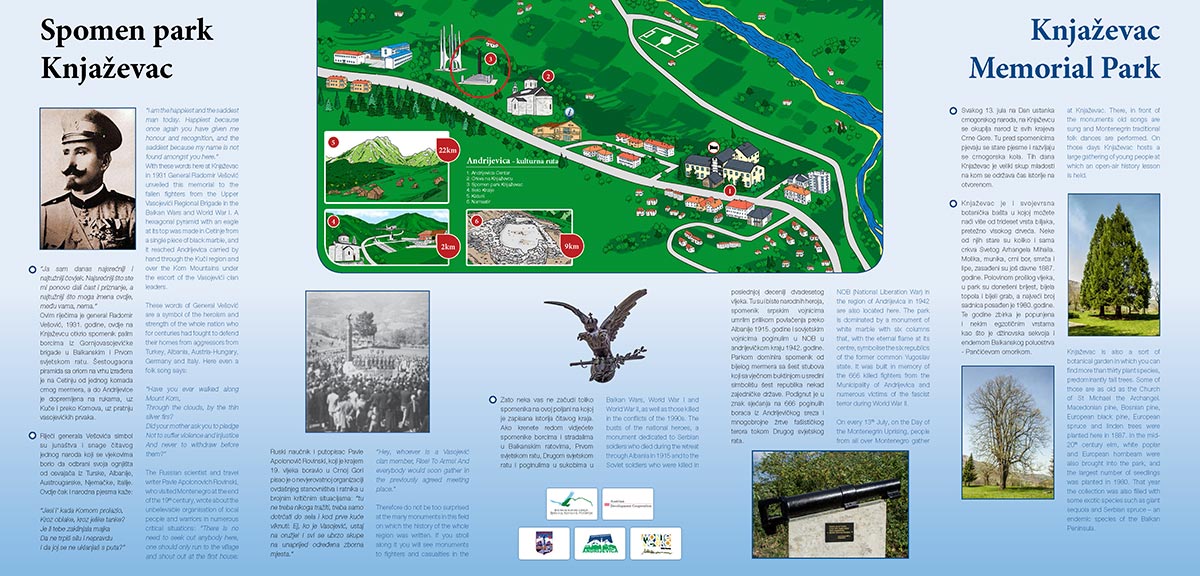“I am the happiest and the saddest man today. Happiest because once again you have given me honour and recognition, and the saddest because my name is not found amongst you here.“ With these words here at Knjaževac in 1931 General Radomir Vešović unveiled this memorial to the fallen fighters from the Upper Vasojevići Regional Brigade in the Balkan Wars and World War I. A hexagonal pyramid with an eagle at its top was made in Cetinje from a single piece of black marble, and it reached Andrijevica carried by hand through the Kuči region and over the Kom Mountains under the escort of the Vasojevići clan leaders.
These words of General Vešović are a symbol of the heroism and strength of the whole nation who for centuries had fought to defend their homes from aggressors from Turkey, Albania, Austria-Hungary, Germany and Italy. Here even a folk song says:
“Have you ever walked along Mount Kom, Through the clouds, by the thin silver firs? Did your mother ask you to pledge Not to suffer violence and injustice And never to withdraw before them?”
The Russian scientist and travel writer Pavle Apolonovich Rovinski, who visited Montenegro at the end of the 19th century, wrote about the unbelievable organisation of local people and warriors in numerous critical situations: “There is no need to seek out anybody here, one should only run to the village and shout out at the first house:
“Hey, whoever is a Vasojević clan member, Rise! To Arms! And everybody would soon gather in the previously agreed meeting place.”
Therefore do not be too surprised at the many monuments in this field on which the history of the whole region was written. If you stroll along it you will see monuments to fighters and casualties in the Balkan Wars, World War I and World War II, as well as those killed in the conflicts of the 1990s. The busts of the national heroes, a monument dedicated to Serbian soldiers who died during the retreat through Albania in 1915 and to the Soviet soldiers who were killed in NOB (National Liberation War) in the region of Andrijevica in 1942 are also located here. The park is dominated by a monument of white marble with six columns that, with the eternal flame at its centre, symbolise the six republics of the former common Yugoslav state. It was built in memory of the 666 killed fighters from the Municipality of Andrijevica and numerous victims of the fascist terror during World War II.
On every 13th July, on the Day of the Montenegrin Uprising, people from all over Montenegro gather at Knjaževac. There, in front of the monuments old songs are sung and Montenegrin traditional folk dances are performed. On those days Knjaževac hosts a large gathering of young people at which an open-air history lesson is held.
Knjaževac is also a sort of botanical garden in which you can find more than thirty plant species, predominantly tall trees. Some of those are as old as the Church of St Michael the Archangel. Macedonian pine, Bosnian pine, European black pine, European spruce and linden trees were planted here in 1887. In the mid- 20th century elm, white poplar and European hornbeam were also brought into the park, and the largest number of seedlings was planted in 1980. That year the collection was also filled with some exotic species such as giant sequoia and Serbian spruce – an endemic species of the Balkan Peninsula.
List of trees:
- Crni bor – Pinus nigra
- Munika – Pinus heldreichii
- Molika – Pinus peuce
- Lipa – Tilia cordata
- Srebrna lipa – Tilia argentea
- Poljski brijest – Ulmus minor
- Gorski brijest– Ulmus glabra
- Crna Topola – Jablan – Populus nigra pyramidalis
- Džinovska sekvoja – Sequoia giganteia
- Pančićeva omorika – Picea omorika
- Srebrna smrča – Picea pungens glauca
- Bodljikava smrča – Picea pungens engelm
- Duglazija – Pseudotsuga viridis
- Pančempres – Chamaecyparis
- Dugoigličava jela – Abies concolor
- Kavkaska smrča – Picea orientalis
- Vankuverska jela – Abies grandis
- Tuja – Thuja
- Bagrem – Robinia pseudoacacia
- Kuglasti bagrem– Robinia pseudoacacia umbraculifera
- Divlji kesten – Aesculus hippocastanum
- Srebrni javor – Acer dasycarpum
- Gorski javor – Acer pseudoplatanus
- Javor negundovac – Acer negundo
- Breza – Betula alba
- Vajmutov bor – Pinus strobus
- Džanarika – Prunus cerasifera
- Platan – Platanus orientalis
- Trešnja – Prunus avium



